中职英语第一册Unit1 (教案)
- 格式:docx
- 大小:20.30 KB
- 文档页数:3
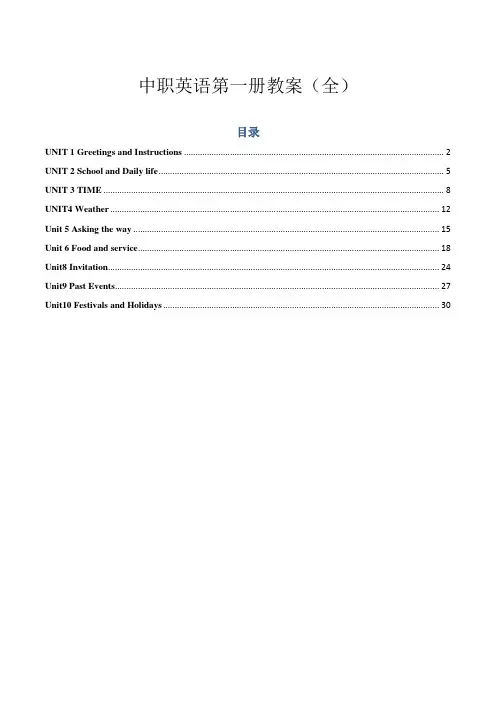
中职英语第一册教案(全)目录UNIT 1 Greetings and Instructions (2)UNIT 2 School and Daily life (5)UNIT 3 TIME (8)UNIT4 Weather (12)Unit 5 Asking the way (15)Unit 6 Food and service (18)Unit8 Invitation (24)Unit9 Past Events (27)Unit10 Festivals and Holidays (30)UNIT 1 Greetings and Instructions一、词汇(课本14页)1. addresspostal addresspostal adj. 邮政的2. bossThis is my boss.worker3.call【教材原文】Please call me Jianjun.请叫我建军好了。
①.命名,把…叫作call sb.sthMay I have your name?call me Tom.叫我汤姆吧。
②call on sb.拜访某人call at sp.拜访某地(3)打电话call sb.(up)给某人打电话I’ll call you this evening.今晚我将给你打电话。
(4)m.电话give sb. a call 2给某人打电话make a phone call打电话This is my friend Mary (call)4. computer5. customer6. e-mail7. greet 打招呼,问好greeting n.问候(通常用复数)【教材原文】Can you greet people in English? 你会用英语打招呼吗?greet each other彼此问候、彼此打招呼We greet each other with smile.我们微笑着彼此打招呼。
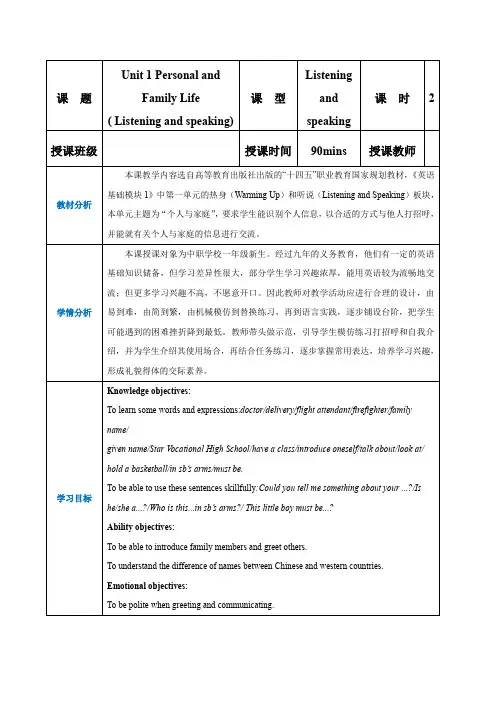
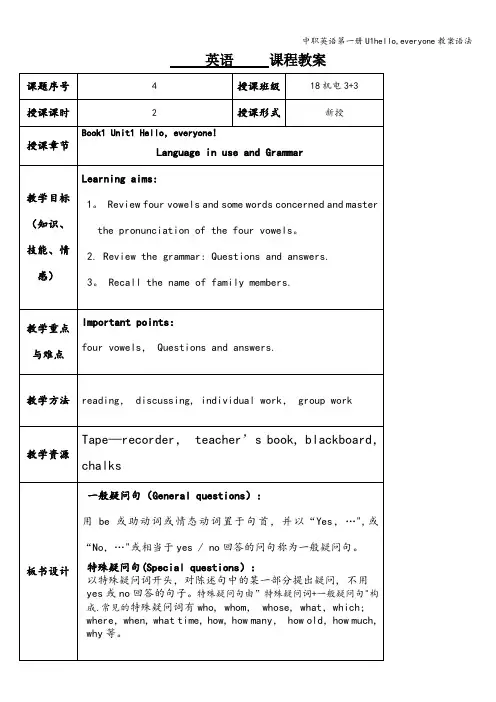
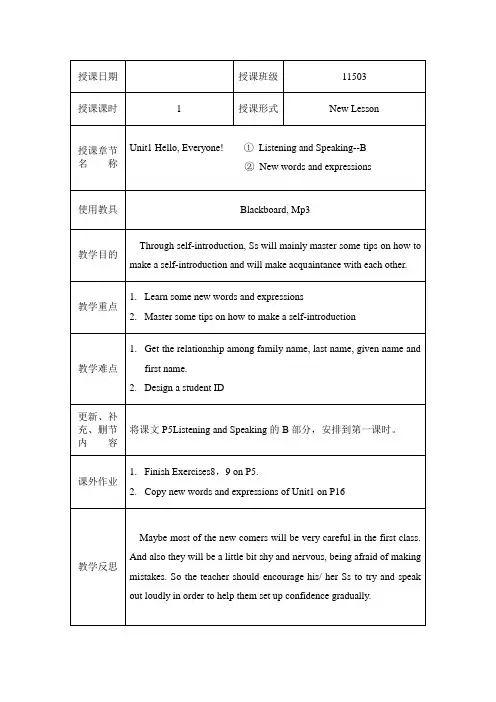


中职英语第一册教案(全)目录UNIT 1 Greetings and Instructions (2)UNIT 2 School and Daily life (5)UNIT 3 TIME (8)UNIT4 Weather (12)Unit 5 Asking the way (15)Unit 6 Food and service (18)Unit8 Invitation (24)Unit9 Past Events (27)Unit10 Festivals and Holidays (30)UNIT 1 Greetings and Instructions一、词汇(课本14页)1. addresspostal addresspostal adj. 邮政的2. bossThis is my boss.worker3.call【教材原文】Please call me Jianjun.请叫我建军好了。
①.命名,把…叫作call sb.sthMay I have your name?call me Tom.叫我汤姆吧。
②call on sb.拜访某人call at sp.拜访某地(3)打电话call sb.(up)给某人打电话I’ll call you this evening.今晚我将给你打电话。
(4)m.电话give sb. a call 2给某人打电话make a phone call打电话This is my friend Mary (call)4. computer5. customer6. e-mail7. greet 打招呼,问好greeting n.问候(通常用复数)【教材原文】Can you greet people in English? 你会用英语打招呼吗?greet each other彼此问候、彼此打招呼We greet each other with smile.我们微笑着彼此打招呼。
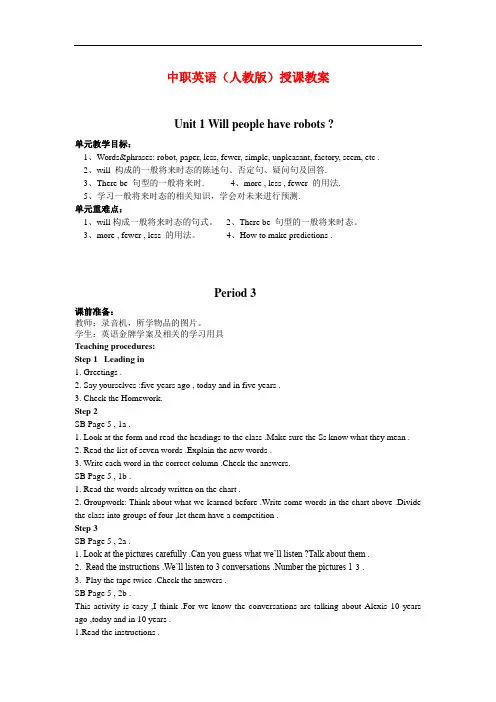
中职英语(人教版)授课教案Unit 1 Will people have robots ?单元教学目标:1、Words&phrases: robot, paper, less, fewer, simple, unpleasant, factory, seem, etc .2、will 构成的一般将来时态的陈述句、否定句、疑问句及回答.3、There be 句型的一般将来时.4、more , less , fewer 的用法.5、学习一般将来时态的相关知识,学会对未来进行预测.单元重难点:1、will构成一般将来时态的句式。
2、There be 句型的一般将来时态。
3、more , fewer , less 的用法。
4、How to make predictions .Period 3课前准备:教师:录音机,所学物品的图片。
学生:英语金牌学案及相关的学习用具Teaching procedures:Step 1 Leading in1. Greetings .2. Say yourselves :five years ago , today and in five years .3. Check the Homework.Step 2SB Page 5 , 1a .1. Look at the form and read the headings to the class .Make sure the Ss know what they mean .2. Read the list of seven words .Explain the new words .3. Write each word in the correct column .Check the answers.SB Page 5 , 1b .1. Read the words already written on the chart .2. Groupwork: Think about what we learned before .Write some words in the chart above .Divide the class into groups of four ,let them have a competition .Step 3SB Page 5 , 2a .1. Look at the pictures carefully .Can you guess what we’ll listen ?Talk about them .2. Read the instructions .We’ll listen to 3 conversations .Number the pictures 1-3 .3. Play the tape twice .Check the answers .SB Page 5 , 2b .This activity is easy ,I think .For we know the conversations are talking about Alexis 10 years ago ,today and in 10 years .1.Read the instructions .2. Pay attention to the sentences and the verbs in the box .3.Play the tape and correct the answers .Step 41. Read the instructions .2. Pairwork. One is Alexis, one is Joe .3. Point out the example in the sample dialogue .Read it to the Ss .4. Talk about Joe’s life now , ten years ago and in ten years .5. Ask some pairs of Ss to say their dialogues .Homework:1. Go over the words .2. 写一篇50个单词左右的小短文,预测与展望未来我们的学习和生活。
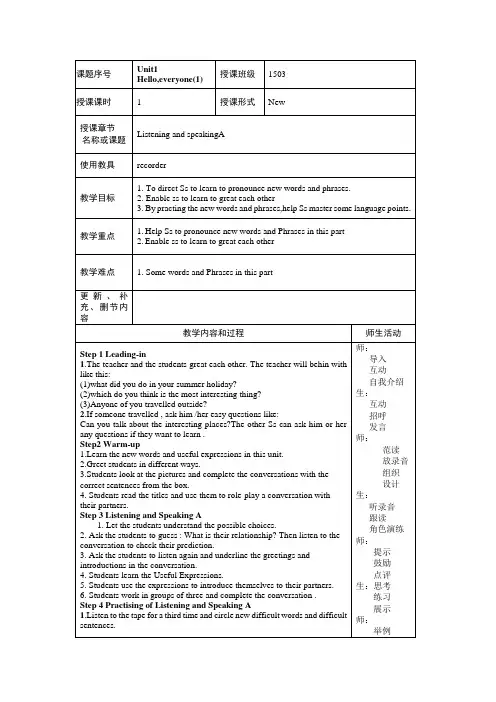
2.Ask the Ss to read “learning strategy”, and ask the Ss to think it over before reading the passage.1) First get into groups: Teach a paragraph for the Ss. The Ss read the paragraph silently, then summarize the paragraph in their own words and share their summaries with the group.2) Do the reading and understanding exercises twice so that the Ss have chances to practice their spoken English and check their understating about the dialogue .3) Ask the Ss to underline the points that they don’t understand.4) Ask the Ss to read the article one by one in group, choose a student to take part in competition.Step 5 Further Reading1. Students listen to the tape.2. Students read after the tape and try to express four different ways of greetings using their body language.3. Let the students think over the meaning of four different ways of greetings .4. Provide much more greeting ways in different countries.5. Try to act out each way of greeting.Step6 Language points1.Got it=I’ve got it=I’ve know/understood it2.call(1)call sb.sth(2)call sb. To do sth(3)call on sb.(4)Call at sb’s3.hope(1)hope to do(2)hope that-clause(3)hope, wisheg.wish sb. To do sth(T)4.hope sb. To do sth(F)Step7 SummaryStudents understand different ways of greeting.讲解对比板书生:听记思考比较理解板书设计Unit1 Hello,everyone (1) Language points1.Got it=I’ve got it=I’ve know/understood it2.calla)call sb.sthb)call sb. To do sthc)call on sb.d)Call at sb’s3.hopea)hope to dob)hope that-clausec)hope, wisheg. wish sb. To do sth(T)hope sb. To do sth(F)课外作业1.学案P1 翻译并背诵词组2.朗读并背诵单词3.熟读对话。
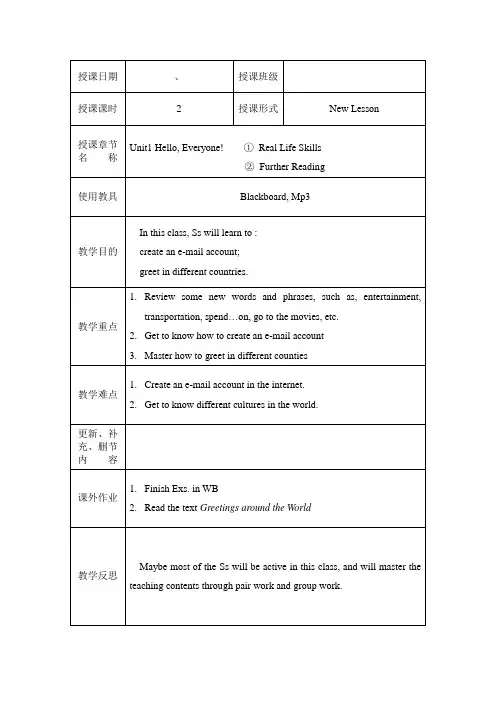
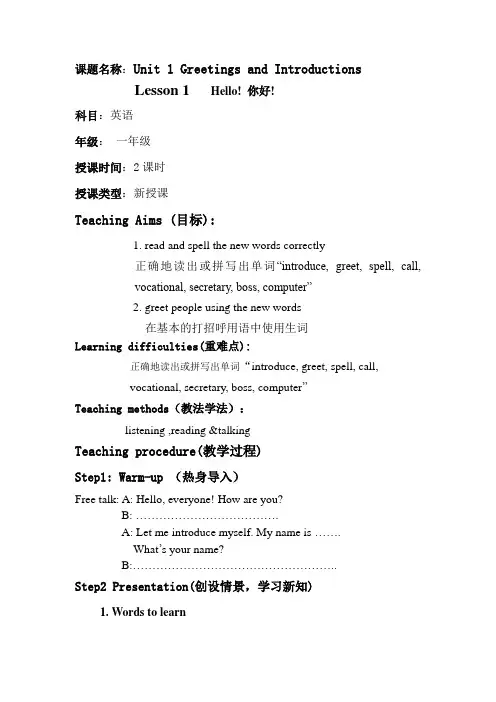
课题名称:Unit 1 Greetings and IntroductionsLesson 1Hello! 你好!科目:英语年级:一年级授课时间:2课时授课类型:新授课Teaching Aims (目标):1. read and spell the new words correctly正确地读出或拼写出单词“introduce, greet, spell, call,vocational, secretary, boss, computer”2. greet people using the new words在基本的打招呼用语中使用生词Learning difficulties(重难点):正确地读出或拼写出单词“introduce, greet, spell, call,vocational, secretary, boss, computer”Teaching methods(教法学法):listening ,reading &talkingTeaching procedure(教学过程)Step1: Warm-up (热身导入)Free talk: A: Hello, everyone! How are you?B: ……………………………….A: Let me introduce myself. My name is …….What’s your name?B:……………………………………………..Step2 Presentation(创设情景,学习新知)1. Words to learn利用给出的音标、图片、英文解释、汉语解释和所举例句五方面的信息,学习词汇,例句部分尽可能记住.2. Task 1 跟读时,注意单词的重音, 长元音/i:/ 和短元音/i/ 发音的区别Task 2 匹配后,写出下面的单词的汉语意思1. greet __________2. introduce __________3. spell __________4. secretary __________5. boss __________6. computer __________7. call __________ 8. vocational __________Task 3&Task 4 根据Task 3, Task 4 的交际用语,分类填表Task 5 你可以使用下面的问候语完成任务Step3 Practice (趣味活动,巩固新知)1. Read the dialogues请学生小组合作完成简单的对话。
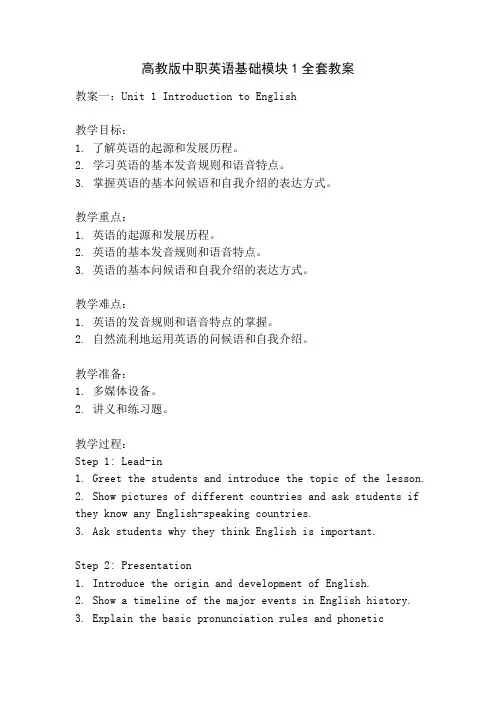
高教版中职英语基础模块1全套教案教案一:Unit 1 Introduction to English教学目标:1. 了解英语的起源和发展历程。
2. 学习英语的基本发音规则和语音特点。
3. 掌握英语的基本问候语和自我介绍的表达方式。
教学重点:1. 英语的起源和发展历程。
2. 英语的基本发音规则和语音特点。
3. 英语的基本问候语和自我介绍的表达方式。
教学难点:1. 英语的发音规则和语音特点的掌握。
2. 自然流利地运用英语的问候语和自我介绍。
教学准备:1. 多媒体设备。
2. 讲义和练习题。
教学过程:Step 1: Lead-in1. Greet the students and introduce the topic of the lesson.2. Show pictures of different countries and ask students if they know any English-speaking countries.3. Ask students why they think English is important.Step 2: Presentation1. Introduce the origin and development of English.2. Show a timeline of the major events in English history.3. Explain the basic pronunciation rules and phoneticfeatures of English.4. Use audio or video materials to demonstrate the correct pronunciation.Step 3: Practice1. Divide the class into pairs or small groups.2. Give students a list of common greetings and ask them to practice using them in different situations.3. Have students practice introducing themselves to each other using the phrases and sentences learned.Step 4: Consolidation1. Review the key points of the lesson, including theorigin and development of English, pronunciation rules, and greetings.2. Ask students to summarize what they have learned intheir own words.Step 5: Assessment1. Give students a short quiz to test their understanding of the lesson.2. Assign homework, such as writing a short paragraph about the importance of English or practicing greetings and self-introductions.教案二:Unit 2 Numbers and Time教学目标:1. 学习基本的数字和时间表达方式。
“外研版”中职国规英语教材基础模块(修订版)第一册Unit 1 School becomes interesting.一、单元整体解读及分析二、分课时教学设计第1课时词汇学习2. 匹配教师展示学校平面图。
通过提问,请学生将课程与上课地点匹配。
1) Where do we have these classes?2) All these classes below are calledsubjects. The classes in labs are calledskill training classes.词或念不准Chemistry和Maths等单词,可以跟着教师一起朗读。
学生根据学校平面图集体回答,把课程和上课地点一一对应起来,最后得出答案:教室和实验室。
学生个别朗读、齐声朗读词汇。
的状态。
既复习了与科目相关的词汇,又为接下来的subject和skilltraining这两个重要词汇的学习做好铺垫。
通过熟悉的校园平面图学习本课重点词汇,自然、直观地引出本课新词汇:skilltraining和subject。
学生可以根据自己的实际能力自由选择用词汇或完整句型回答问题,为接下来的听、说做好热身。
水到渠成地理解词汇。
18’听力练习1.“拼图”①教师第一遍播放听力材料,要求学生:Remember what you hear in thedialogue. Any words, phrases, orsentences are ok.教师把学生回答的内容按顺序写在黑板上。
2.“拼图”②教师第二遍播放听力材料,要求学生:Listen again and get moreinformation.教师把学生听到的信息再次按顺序补充在黑板上。
3. 补充“拼图”,要求学生:Discuss with your group members andfill in the blanks with your ownwords. Then show the dialogue to theclass.4. 完成“拼图”教师第三遍播放听力材料。
中职英语基础模块 1 教学设计(教案、学案)Unit 1 第一课时Book1 Unit 1 Nice to meet you!一、学情分析本单元是新生入学的第一单元,教学重点是活用招呼用语、相互了解个人基本信息、制作个人名片、学习不同职业的表达与描述以及练习发音。
就学习英语而言,职业学校的许多学生是胆大心粗,能说不会写或写不到位。
因此,教师在教学过程中应充分利用学生的特点开展相应活动。
我们可以利用学生胆大、敢说的特点,充分利用头脑风暴法采集相关素材,开展如招呼用语集锦、刨根问底探隐私、名片栏目大荟萃等活动。
教学中名片栏目的设计、描述不同职业、圆润的发音是本单元难点。
圆润的发音要靠长期的示范与坚持来实现。
名片中各栏目的设计可以集体讨论商定,个人名片设计则可以体现个性化、专业化,并决出最佳名片设计奖,教师还可以请学生一起收集生活中的名片,探讨名片的基本要素和个性特色。
职业的描述教师可以借助体态语、道具、图片、视频等来推进,还可以设计相应的练习强化学生的认知。
本单元设计分为4个课时:第一课时lead-in + listening and speaking第二课时reading and writing第三课时language in use + vocabulary consolidation第四课时unit task + pronunciation practice第一课时Lead-in + Listening & Speaking二、教材分析1.教学内容本课时系教材《英语1》(基础模块高教版)第一单元的第一课时,包括Lead-in & Listening and speaking 两部分,具体内容为:招呼用语,听懂并掌握询问和提供个人信息的词汇、句型。
2.教学重点、难点⑴教学重点:招呼用语,听懂并掌握询问和提供个人信息的词汇、句型⑵教学难点:个人信息的词汇、句型三、教学目标1.知识目标⑴掌握与个人信息相关的词汇,如name, first name; last name; name card; telephone number; age; address; e-mail address; job (engineer; manager; secretary; teacher; student; doctor; nurse; singer; fans); position(boss);⑵掌握提供或询问个人信息时所使用的句型,如:1) about greeting:Good morning. Hi. Nice to meet you.2) about personal informationWhat’s you name?Where are you from? Which company are you from?。
Unit 1 Glad to meet you!(第四课时教学设计)一、教材分析1.教学内容本课时系教材《英语基础教程1》第一单元的第四课时,教学内容包括Vocabulary practice中的V ocabulary practice部分和Supplementary reading,具体内容为:词汇练习和拓展阅读。
本课时内容是对本单元所学知识(特别是词汇)的总结和回顾,有助于学生进一步掌握关键词汇,对单元知识产生清晰的认识。
同时,拓展阅读的教学有助于帮助学生延伸课堂知识,教师可以侧重于训练学生阅读能力。
2.教学重点、难点⑴教学重点对本单元重点词汇、短语的提高性学习;对阅读文段的学习和理解;⑵教学难点对阅读文段的理解;二、教学目标1.知识目标⑴掌握与见面礼节、个人信息(含名片)相关的词汇、短语;⑵理解、读懂阅读文段;2.能力目标⑴学生能流利使用关于见面礼节、个人信息(含名片)的词汇、短语;⑵能根据要求从文段获取相关信息,并理解其蕴含的文化差异;3.情感目标学生能认识到不同的国家具有不同的礼仪、礼节、风俗习惯,并理解到良好的礼仪对于个人的重要性。
三、教学步骤Step One Lead-in1.The teacher plays the video for students. Ask the students to take some notes while they arewatching the video.e.g. T:Do you know how to offer or accept a name card? Let’s watch a video clip about howto use your name card.(设计意图:建议授课老师播放如《金正昆谈礼仪之名片礼仪》等关于名片礼仪的视频,既激发学生的学习兴趣,也利于突出本单元的主题。
)2. The students exchange their name cards with each other.(设计意图:职场情境模拟,教师也可参与名片互换环节。
中职英语Unit1Greetings(教学设计)Unit 1 GreetingsLesson 1 Nice to meet you!一、教材分析1. 教学内容本课时系教材《英语》(高教版)第1单元的第一课时。
本课时主要让学生学习问候他人以及介绍自己的相关词汇,通过听说训练掌握问候他人和介绍自己的相关表达方式,为本单元之后的学习任务做好语言上的准备。
同时,本课时又是学生新学期的第一课,因此掌握相关的语言点也有助于师生以及生生之间更好地了解与熟悉。
2. 教学重点、难点(1)教学重点学生能正确拼读本课中关于问候他人以及介绍自己的词汇,并根据听到的信息标注问候和自我介绍的句型,能运用所学的句型进行问候与自我介绍的对话。
(2)教学难点学生能够运用所学的词汇和句型在真实的情境中进行相互问候与自我介绍的对话。
二、教学目标1. 知识目标(1)学生能正确拼读Canada,grade,classmate,vocational,meet,welcome等词汇。
(2)学生能掌握问候他人与介绍自己的表达方式:Hello/Hi.Nice to meet you!May I have your name?My name is ….Which class are you in?I’m in Class…2.能力目标(1)学生能根据听力中的信息标注问候他人和介绍自己的相关句型。
(2)学生能够运用所学的词汇和句型在真实的情境中进行相互问候和自我介绍的对话。
3. 情感目标学生通过本节课的学习,培养学生对英语学科的学习兴趣,建立和增强学习英语的信心。
同时,让学生在潜移默化的学习中养成礼待他人的好习惯。
三、教学步骤Step I Warm –up1.Students discuss in groups and guess “What may Tom say?” accordingto the picture given.2.Each group write down their answers and the teacher chooses severalgroups to share their answers in class.(设计意图:学生根据图片的提示,通过小组讨论,可以发挥自己的想象力和快速搜集自己已有的词汇储备,既能激发学生的积极性又能增强团队合作意识;老师也能根据学生已储备的词汇对本节课要讲解的词汇有一个程度上的把握。